A Behind-the-Scenes Look at What It Takes to Serve 1,700 Meals Daily in the Tenderloin
July is National Culinary Arts Month, recognizing professional cooks and chefs who sustain and delight communities through innovative recipes and meals. This month, St. Anthony Foundation is thrilled to spotlight the incredible individuals and their work behind the scenes at St. Anthony’s Dining Room, a staple of the Tenderloin neighborhood for over 70 years
July 27, 2023
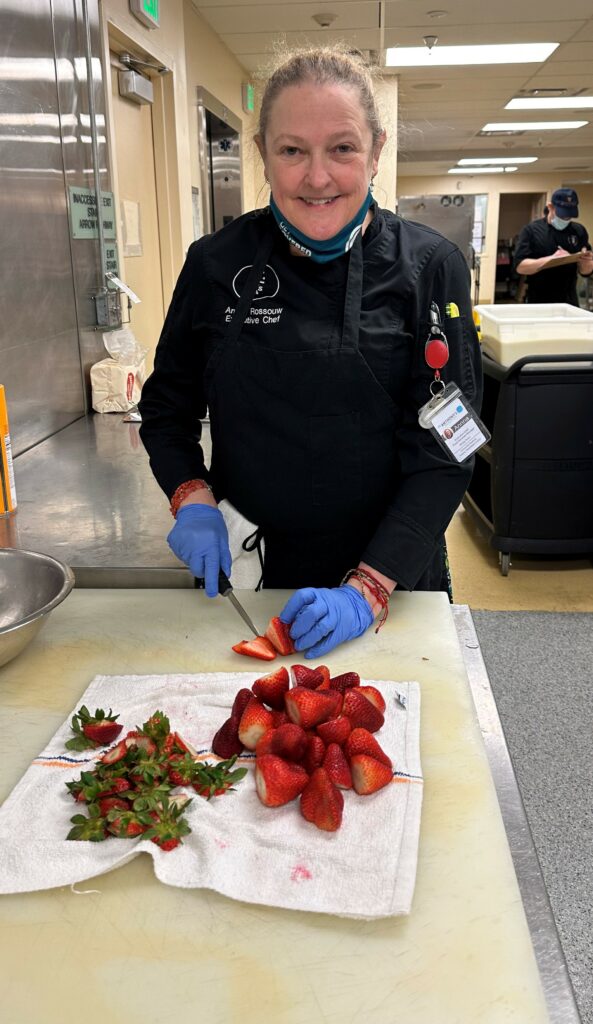
The scent of freshly baked bread and sausage and lentil stew wafts through the dining room. Behind the food counter, eight volunteers in burgundy aprons are filling up trays for people waiting in line. The room is bustling with activity: hundreds of people are eating a hot meal, catching up on the news, joking, sometimes even hugging. There are young and old gathered here, families with small children and people in wheelchairs—their trays are brought directly to their tables.
It’s a typical day at St. Anthony’s Dining Room, which serves approximately 1,700 meals a day, every day of the year, to residents of the Tenderloin neighborhood and San Francisco at large. That’s more than 47 million meals since the Dining Room opened in 1950, and counting. Free meals given with dignity have kept the Dining Room in demand ever since, in a neighborhood where half of the residents live below poverty level and in a city where 20,000 people experienced homelessness just last year.
Yet the Dining Room does more than feed those in need. It also offers hope and a path forward. The staff engages guests in activities and games in a safe communal environment. The Dining Room also employs and trains people in addiction recovery and those formerly incarcerated (in fact, 28 percent of all St. Anthony Foundation’s staff are former guests of its free addiction recovery program, clothing donation service, job training, the Dining Room and others).
But there’s something else that makes the Dining Room shine. Its kitchen recently started baking bread onsite and developing new nutritious recipes.
“Food is how we give our love,” says Executive Chef and Food Services Manager Annria Rossouw, who came to lead the Dining Room just under two years ago.
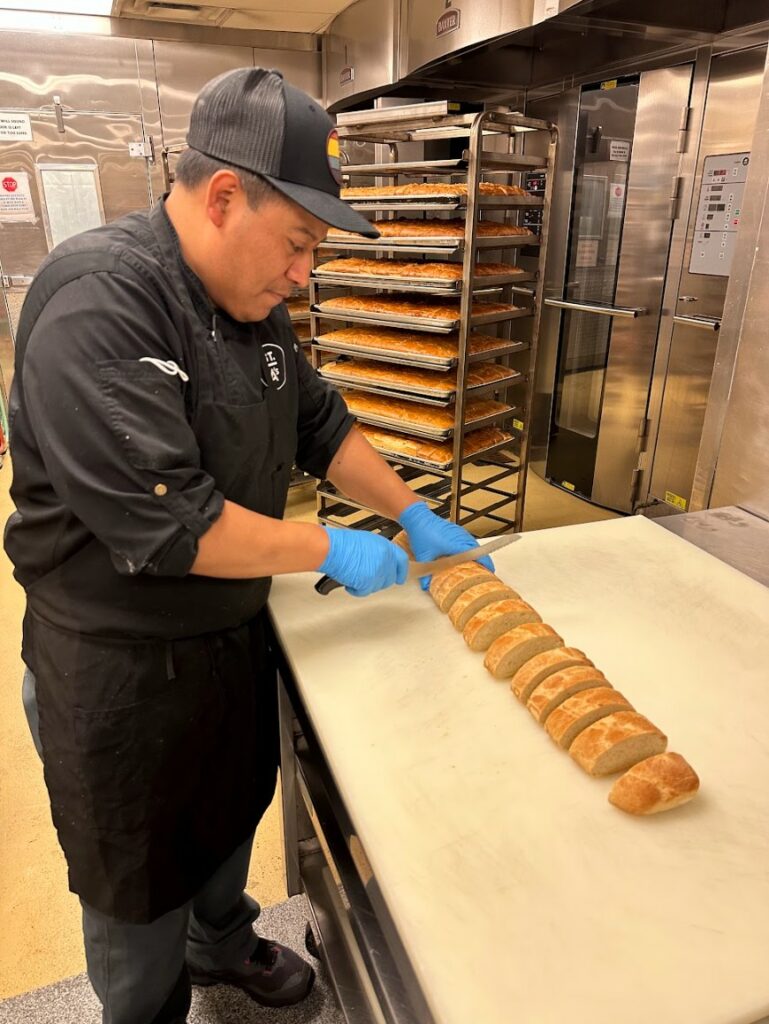
In March 2023, Chef Annria and Bread Chef Edwin Juarez, formerly in charge of the savory dishes, got the kitchen set up for daily bread baking. They tested recipes and got baguette pans. The kitchen now churns out approximately 100 loaves per day, in addition to regular desserts. Their goal is to produce everything in house.
“The friar who started St. Anthony’s began by giving out bread to the homeless, but nobody’s ever made bread here,” explains Chef Annria, whose workday begins at 5:15 in the morning. “Now, we’re baking the bread to give out. Isn’t that amazing?”
Mondays and Wednesdays are focaccia days, while Tuesdays and Thursdays are reserved for French baguettes. On Fridays they make “a nice wheat bread,” says Chef Annria.
And when Chef Edwin has some extra time, he rolls a few whole wheat baguettes, too.
“They love the bread and the pastries,” says Chef Edwin, who’s been trained in the French culinary tradition and previously worked in the city’s French eateries, such as Cafe de la Presse and Fleur de Lys, now closed, as well as in Italian and Mediterranean restaurants.
Bread is an important aspect of the Franciscan order. In 1263, a legend goes, an Italian woman prayed to St. Anthony of Padua, the patron of the poor, to heal her child and promised to give corn to the poor if her child’s health was restored. A few centuries later, a shopkeeper in France couldn’t open the door to her bakery and prayed to St. Anthony, promising to share loaves with the poor if her prayer was heard. It was.
Since then, St. Anthony Bread refers to offerings to the poor and to bread loaves that are blessed and shared in honor of the saint.
Chef Annria also launched a Recipe and Development program with a fitting Bay Area moniker: R&D Lab. She and Chef Edwin start with two induction plates and two pots and see how a particular dish could scale from one portion to well over one thousand.
“Everything we want to do, we tie it in with our R&D program. Usually by the third try the recipe is perfected. We do pretty good, I think,” says Chef Annria, laughing. Since coming on board to lead the Dining Room, she’s built a database of the recipes she and the staff developed, organized by protein and cuisine, with a whopping 206 entries already recorded.
Recently the chefs experimented with a new chutney recipe and ended up making two kettles, each holding 65 gallons.
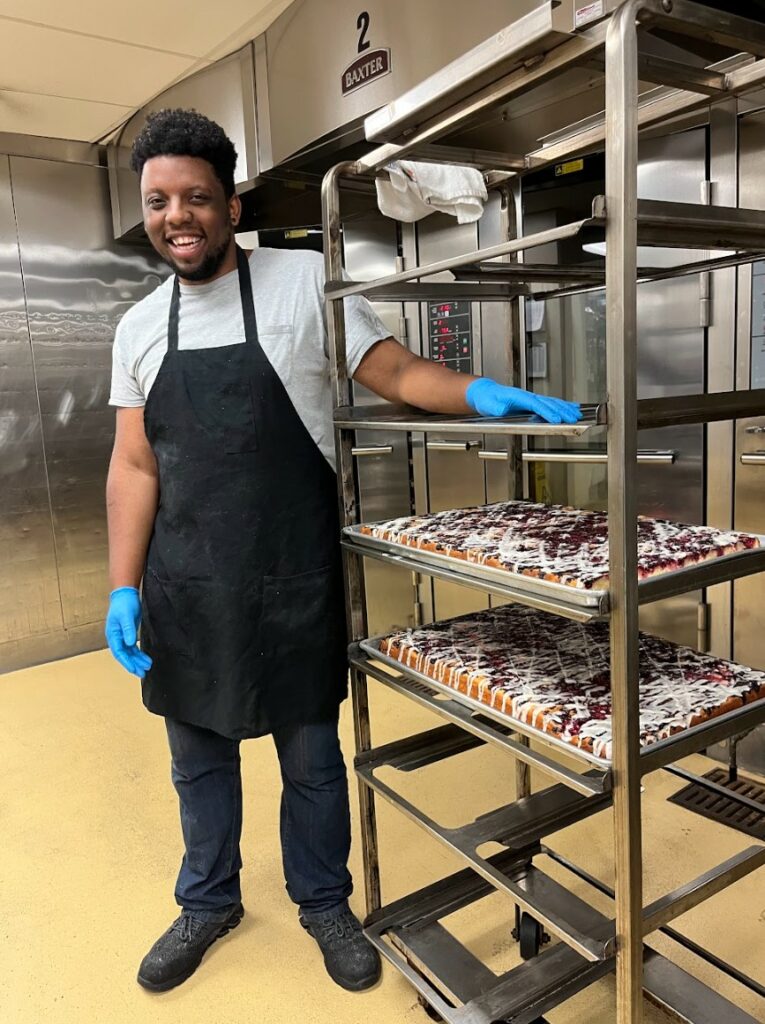
Other chefs are also encouraged to try out new ideas. Chef Ben Judd, who is vegan, has developed a recipe for vegetarian tempura for the whole house. “It was tasty,” recalls Chef Annria. “They had to slap my hand away!”
Chef Forrest loves chiles, so he prepared five buckets of Cochinita Pibil, a sauce with slow-cooked pork originating in the Mayan tradition. Meanwhile, Sous chef John is a master at cooking beans.
The creativity stays within the limits of the budget and the food donations the kitchen receives. Last month, for example, a large donation of bread came in, so Chef Edwin whipped up bread pudding. “If we have a lot of apple donations, I do apple pie,” he explains. “I do a lot of things.” Born in Guatemala, he also cooks moles and salsas using the Mayan recipes he learned from his mother.
With a surplus of donated hot dogs in the freezer, the staff is utilizing them in creative ways, from gumbo to French-style franks and beans. Chef Annria shows off the monthly menu on the wall.
“Thai basil beef, apple chicken,” she goes down the list. “There’s our famous hot dogs again. This is new, that’s new. That is also new. Beef goulash—ooh, that’s the one they really love! When I can get fish at a good price, I do it on a Friday.”
In addition to flavor and variety, the staff’s imperative is to prepare food that’s healthy. Their guests don’t have access to nutritious food; many are unsheltered. Some are in recovery and crave sugar. The recipes Chef Annria and Chef Edwin develop are low in sugar and sweetened with fruit whenever possible. There’s always a vegetarian option available, with vegetables donated by the San Francisco-Marin Food Bank.
“We don’t do high sodium, although we season our food well. The only canned stuff we really use is tomato,” explains Chef Annria. “We cook with spices, we cook a lot with turmeric, which is very good for the liver. We put fresh curry leaves in our food,” she says. “And we cook with a lot of garlic, which is an antiseptic. People sleep on the pavement, it’s cold. So we try in our little way to keep it as healthy as we can.”
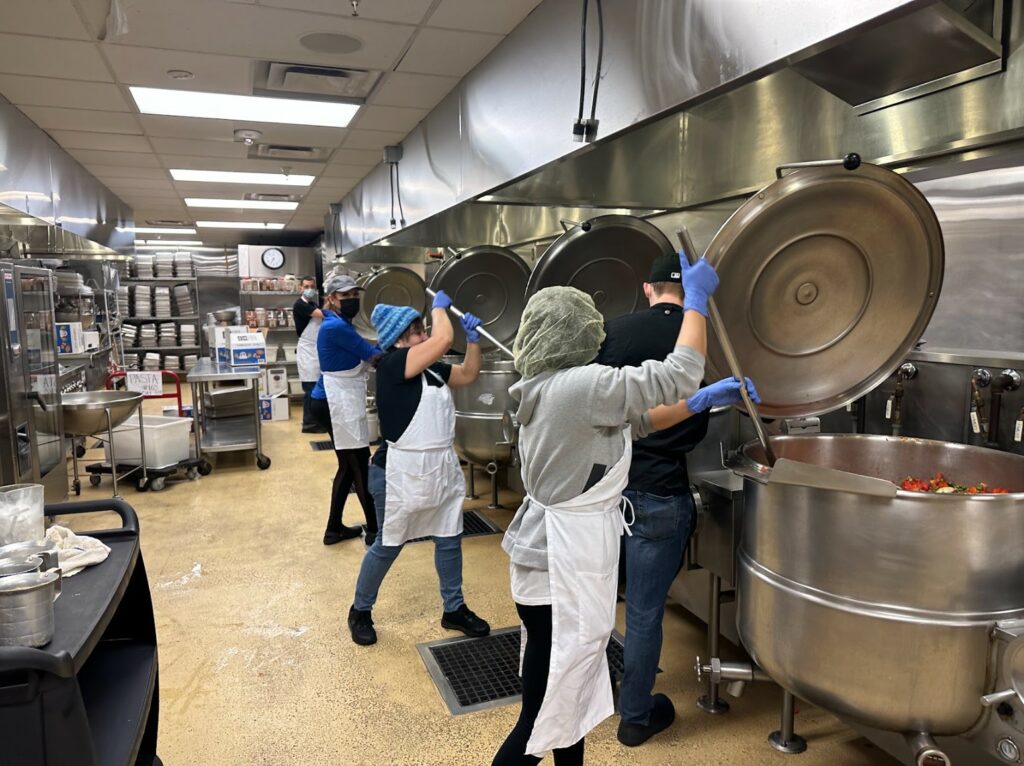
The dishes tend to have a softer texture, rather than overly crunchy or chewy, to accommodate diners of all ages and physical abilities.
After the lunch service, the staff gives out 150 sealed packages of the remaining food by the door, to those who missed it.
Both chefs say they feel more appreciated for their work than ever before. People even thank them on the street, recognizing their jackets.
“If you work in a restaurant, nobody says thank you to you except for the chef or the owner,” Chef Edwin says. “But here, they say ‘Thank you, chef, thank you for the food.’ It touches you. Last time I almost cried. I love what I do. That’s what makes me happy every day to come to work.” Sometimes he sees people finish their meals while sitting on the pavement.
It takes a robust team to run such a tight ship. Approximately 30 people work in the kitchen, including 20 kitchen assistants, four chefs, two prep chefs and three managers, in addition to an administrative coordinator. Chefs train those in junior roles, many of whom have never worked in a restaurant before.
As the meal service winds down in the afternoon, the space is transformed. Someone’s mopping the floor. Someone else is wiping down the kitchen walls. The uniformed staff in the dishwashing room is cleaning while listening to an upbeat song. A priest from St. Boniface Church next door, Brother Andrew, is chatting with the diners outside. He often helps in the kitchen, too.
There’s camaraderie in the air as the staff clock out for the day, sometimes with jokes and words of encouragement: “Great job today, buddy!” “See you tomorrow, buddy!”
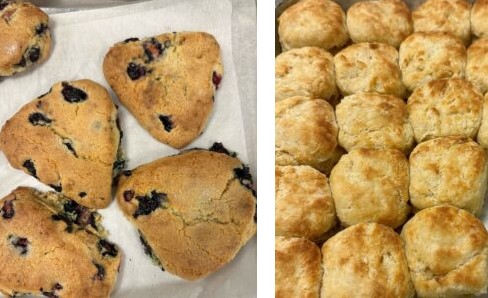
For many of them, the Dining Room brings back memories of hard times and new beginnings. One chef used to eat here with her own family after they’d immigrated with barely any money in their pockets. A few others attended Father Alfred Center, St. Anthony’s addiction recovery program, and now work in the Dining Room, both in entry-level and leadership positions.
“We’re just a big family,” says Chef Annria. The ability to brighten someone’s day when they’re struggling is what motivates her to cook from the heart. “It’s their dining room. It’s their home,” she says. “They get a plate of food and they get a warm, dry place to sit, and they’re welcome, you know? It makes them feel like they’re important.”













































